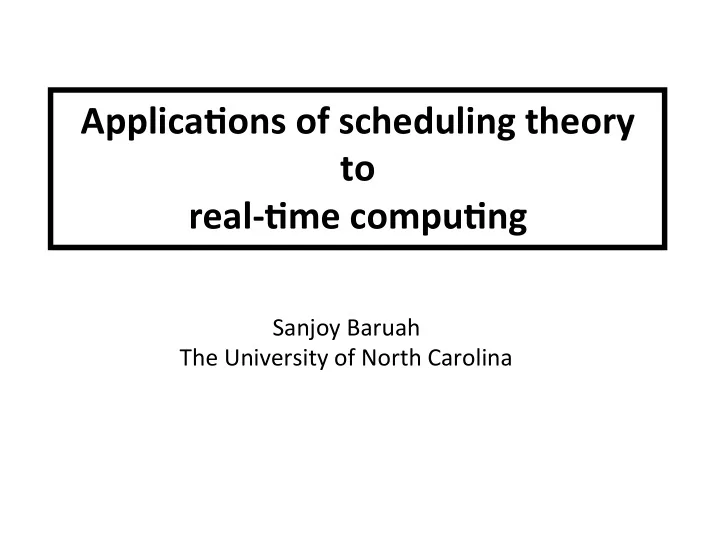

Applica'ons of scheduling theory to real-'me compu'ng Sanjoy Baruah The University of North Carolina
Applica'ons of scheduling theory to real-'me compu'ng Scheduling theory is widely applicable to real->me compu>ng But real->me systems are represented using different models Solu>on objec'ves may also be different This talk: some interes>ng models and associated scheduling problems - Precedence-constrained scheduling - Mixed cri>cality - “SoG” real->me systems
Condi'onal code Condi'onal DAGs Precedence constrained scheduling #pragma omp parallel num threads(N){ #pragma omp master { #pragma omp task{ if (condition) T1 #pragma omp task{//T1} else { #pragma omp task {//T2 } T2 #pragma omp task {//T3 } T3 #pragma omp task {//T4 } T4 } }}}
Condi'onal DAGs Precedence constrained scheduling Volume = 24 Length = 8 Volume = 20 Length = 10 Volume = 24 Length = 10 Does not preserve feasibility or infeasibility
Condi'onal DAGs Precedence constrained scheduling … Exponen>ally many paths to consider…
Condi'onal DAGs Precedence constrained scheduling Qn : What is the computa>onal complexity of compu>ng the makespan? Qn : Determine a suitable scheduling strategy (e.g., List Scheduling) with good predictable makespan bound Collec'ons of sporadic DAG tasks – recur with specified min. inter-arrival dura>on
Mixed cri'cality – makespan minimiza'on Blue (non-cri>cal) and red (cri>cal) jobs Job j has two execu>on->me es>mates: C j (lo) and C j (hi). [C j (lo) ≤ C j (hi)] Less conserva>ve More conserva>ve Seman>cs: - If each job j signals comple>on upon execu>ng for ≤ C j (lo) >me, then all jobs should complete execu>on - If each job j signals comple>on upon execu>ng for ≤ C j (hi) >me, then all red jobs should complete execu>on Schedule a given collec>on of mixed-cri>cality jobs to minimize makespan - Upon a single machine – cri>cality monotonic scheduling - Non-preemp>ve, on mul>ple machines – Vector Scheduling - Preemp>ve? Extensions : Release dates; deadlines; recurrent tasks
Mixed cri'cality – makespan minimiza'on Blue (non-cri>cal) and red (cri>cal) jobs Job j has two execu>on->me es>mates: C j (lo) and C j (hi). [C j (lo) ≤ C j (hi)] I’m looking for more focus on algorithms that work fast with respect to problems whose size, n , is feasible. Most of today’s Seman>cs: literature is devoted to algorithms that are asympto>cally great, - If each job j signals comple>on upon execu>ng for ≤ C j (lo) >me, but they are helpful only when n exceeds the size of the universe. then all jobs should complete execu>on - If each job j signals comple>on upon execu>ng for ≤ C j (hi) >me, then all red jobs should complete execu>on - Donald Knuth , 2014. In Twenty Ques+ons for Donald Knuth Schedule a given collec>on of mixed-cri>cality jobs to minimize makespan - Upon a single machine – cri>cality monotonic scheduling - Non-preemp>ve, on mul>ple machines – Vector Scheduling - Preemp>ve? Qn : Determine prac>cal solu>ons to the non-preemp>ve problem [Prac>cally useful algorithms for vector scheduling]
Weakening the HARD -REAL-TIME requirement –all deadlines must be met Bounded tardiness Skip-over tasks (m,k)-firm tasks
Tardiness bounds Given a workload specified in some model and a scheduling algorithm / environment Determine the maximum tardiness experienced by en>>es in the workload Collec>on of sporadic tasks. τ i = (C i , T i ) C i – worst-case execu>on >me (WCET) T i – minimum inter-arrival dura>on (“period”) Generates jobs ≥ T i >me apart, each with exec. requirement ≤ C i and deadline T i >me later T i
Tardiness bounds Given a workload specified in some model and a scheduling algorithm / environment Determine the maximum tardiness experienced by en>>es in the workload Collec>on of sporadic tasks preemp've EDF , on iden'cal machines Example : τ 1 = (2, 3), τ 2 = (2, 3), τ 3 = (8, 12) upon 2 machines 0 1 2 3 4 5 6 7 8 9 10 11 12 13 14 15
Tardiness bounds Given a workload specified in some model and a scheduling algorithm / environment Determine the maximum tardiness experienced by en>>es in the workload Collec>on of sporadic tasks preemp've EDF , on iden'cal machines Qn : Determine the maximum tardiness that may be experienced by each task’s jobs Qn : Repeat, for when tasks may have deadline parameters different from periods Qn : Analogous ques>ons for uniform machines Qn : Propose “appropriate” scheduling algorithms that minimize tardiness
Tardiness bounds Given a workload specified in some model and a scheduling algorithm / environment Priority-based scheduling algorithms for recurrent tasks Determine the maximum tardiness experienced by en>>es in the workload - Fixed-Task Priori>es (e.g., Rate-Monotonic) - Fixed-Job Priori>es (e.g., EDF) Collec>on of sporadic tasks preemp've EDF , on iden'cal machines - Dynamic Priority (e.g., Least Laxity) Qn : Determine the maximum tardiness that may be experienced by each task’s jobs Qn : Repeat, for when tasks may have deadline parameters different from periods Qn : Analogous ques>ons for uniform machines Qn : Propose “appropriate” scheduling algorithms that minimize tardiness
Other relaxa'ons of hard-real-'me The skip-over model – each sporadic task has a skip parameter s . At least s completed jobs between successive skipped jobs The (m,k)-firm model. At least m of every k consecu>ve jobs must execute correctly Feasibility analysis known to be NP-hard (even on uniprocessors) Good approximate scheduling algorithms?
Condi>onal precedence-constrained jobs The computa>onal complexity of makespan minimiza>on The behavior of list-scheduling Mixed-cri>cality systems Makespan minimiza>on for preemp>ve scheduling More “prac>cal” algorithms for non-preemp>ve scheduling Not all deadlines need be met Tardiness bounds for EDF on iden>cal/ uniform machines Scheduling algorithms with bener (smaller) tardiness bounds Approxima>on algorithms for other models – skip-over, (m,k), etc.
Recommend
More recommend